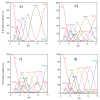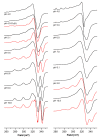A Deeper Insight in Metal Binding to the hCtr1 N-terminus Fragment: Affinity, Speciation and Binding Mode of Binuclear Cu2+ and Mononuclear Ag+ Complex Species
- PMID: 35328348
- PMCID: PMC8953729
- DOI: 10.3390/ijms23062929
A Deeper Insight in Metal Binding to the hCtr1 N-terminus Fragment: Affinity, Speciation and Binding Mode of Binuclear Cu2+ and Mononuclear Ag+ Complex Species
Abstract
Ctr1 regulates copper uptake and its intracellular distribution. The first 14 amino acid sequence of the Ctr1 ectodomain Ctr1(1-14) encompasses the characteristic Amino Terminal Cu2+ and Ni2+ binding motif (ATCUN) as well as the bis-His binding motif (His5 and His6). We report a combined thermodynamic and spectroscopic (UV-vis, CD, EPR) study dealing with the formation of Cu2+ homobinuclear complexes with Ctr1(1-14), the percentage of which is not negligible even in the presence of a small Cu2+ excess and clearly prevails at a M/L ratio of 1.9. Ascorbate fails to reduce Cu2+ when bound to the ATCUN motif, while it reduces Cu2+ when bound to the His5-His6 motif involved in the formation of binuclear species. The histidine diade characterizes the second binding site and is thought to be responsible for ascorbate oxidation. Binding constants and speciation of Ag+ complexes with Ctr1(1-14), which are assumed to mimic Cu+ interaction with N-terminus of Ctr1(1-14), were also determined. A preliminary immunoblot assay evidences that the anti-Ctr1 extracellular antibody recognizes Ctr1(1-14) in a different way from the longer Ctr1(1-25) that encompasses a second His and Met rich domain.
Keywords: Ctr1; affinity; antibody recognition; copper; model transporter; reductase; silver; speciation.
Conflict of interest statement
The authors declare no conflict of interest.
Figures







Similar articles
-
Sequence proximity between Cu(II) and Cu(I) binding sites of human copper transporter 1 model peptides defines reactivity with ascorbate and O2.J Inorg Biochem. 2016 May;158:70-76. doi: 10.1016/j.jinorgbio.2015.12.021. Epub 2015 Dec 30. J Inorg Biochem. 2016. PMID: 26778425 Free PMC article.
-
The Cu(II) affinity of the N-terminus of human copper transporter CTR1: Comparison of human and mouse sequences.J Inorg Biochem. 2018 May;182:230-237. doi: 10.1016/j.jinorgbio.2018.01.011. J Inorg Biochem. 2018. PMID: 29402466
-
Model Peptide Studies Reveal a Mixed Histidine-Methionine Cu(I) Binding Site at the N-Terminus of Human Copper Transporter 1.Inorg Chem. 2015 Sep 8;54(17):8544-51. doi: 10.1021/acs.inorgchem.5b01162. Epub 2015 Aug 10. Inorg Chem. 2015. PMID: 26258435
-
Model peptides provide new insights into the role of histidine residues as potential ligands in human cellular copper acquisition via Ctr1.J Am Chem Soc. 2011 Mar 30;133(12):4427-37. doi: 10.1021/ja108890c. Epub 2011 Mar 4. J Am Chem Soc. 2011. PMID: 21375246 Free PMC article.
-
Designed Metal-ATCUN Derivatives: Redox- and Non-redox-Based Applications Relevant for Chemistry, Biology, and Medicine.iScience. 2020 Nov 10;23(12):101792. doi: 10.1016/j.isci.2020.101792. eCollection 2020 Dec 18. iScience. 2020. PMID: 33294799 Free PMC article. Review.
Cited by
-
Molecular interactions, structural effects, and binding affinities between silver ions (Ag+) and amyloid beta (Aβ) peptides.Sci Rep. 2025 Feb 13;15(1):5439. doi: 10.1038/s41598-024-59826-6. Sci Rep. 2025. PMID: 39948350 Free PMC article.
-
Unveiling the promising anticancer effect of copper-based compounds: a comprehensive review.J Cancer Res Clin Oncol. 2024 Apr 25;150(4):213. doi: 10.1007/s00432-024-05641-5. J Cancer Res Clin Oncol. 2024. PMID: 38662225 Free PMC article. Review.
-
What Is the Correlation between Preeclampsia and Cancer? The Important Role of Tachykinins and Transition Metal Ions.Pharmaceuticals (Basel). 2023 Feb 28;16(3):366. doi: 10.3390/ph16030366. Pharmaceuticals (Basel). 2023. PMID: 36986466 Free PMC article. Review.
-
Sequence-Activity Relationship of ATCUN Peptides in the Context of Alzheimer's Disease.Molecules. 2022 Nov 15;27(22):7903. doi: 10.3390/molecules27227903. Molecules. 2022. PMID: 36432004 Free PMC article.
-
EPR Spectroscopy Provides New Insights into Complex Biological Reaction Mechanisms.J Phys Chem B. 2022 Oct 6;126(39):7486-7494. doi: 10.1021/acs.jpcb.2c05235. Epub 2022 Sep 22. J Phys Chem B. 2022. PMID: 36137278 Free PMC article. Review.
References
-
- Linder M.C. Biochemistry of Copper. Springer; Boston, MA, USA: 1991. Introduction and Overview of Copper as an Element Essential for Life.
MeSH terms
Substances
LinkOut - more resources
Full Text Sources
Research Materials
Miscellaneous

